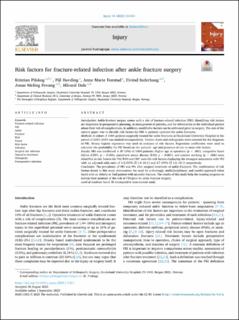| dc.contributor.author | Pilskog, Kristian | |
| dc.contributor.author | Høvding, Pål | |
| dc.contributor.author | Fenstad, Anne Marie | |
| dc.contributor.author | Inderhaug, Eivind | |
| dc.contributor.author | Fevang, Jonas Meling | |
| dc.contributor.author | Dale, Håvard | |
| dc.date.accessioned | 2024-01-16T09:41:13Z | |
| dc.date.available | 2024-01-16T09:41:13Z | |
| dc.date.created | 2023-10-27T08:55:44Z | |
| dc.date.issued | 2023 | |
| dc.identifier.issn | 0020-1383 | |
| dc.identifier.uri | https://hdl.handle.net/11250/3111712 | |
| dc.description.abstract | Introduction
Ankle fracture surgery comes with a risk of fracture-related infection (FRI). Identifying risk factors are important in preoperative planning, in management of patients, and for information to the individual patient about their risk of complications. In addition, modifiable factors can be addressed prior to surgery. The aim of the current paper was to identify risk factors for FRI in patients operated for ankle fractures.
Methods
A cohort of 1004 patients surgically treated for ankle fractures at Haukeland University Hospital in the period of 2015–2019 was studied retrospectively. Patient charts and radiographs were assessed for the diagnosis of FRI. Binary logistic regression was used in analyses of risk factors. Regression coefficients were used to calculate the probability for FRI based on the patients’ age and presence of one or more risk factors.
Results
FRI was confirmed in 87 (9%) of 1004 patients. Higher age at operation (p < .001), congestive heart failure (CHF), p = 0.006), peripheral artery disease (PAD, p = 0.001), and current smoking (p = .006) were identified as risk factors for FRI. PAD and CHF were the risk factors displaying the strongest association with FRI with an adjusted odds ratio of 4.2 (95% CI 1.8–10.1) and 4.7 (95% CI 1.6–14.1) respectively.
Conclusion
The prevalence of FRI was 9% after surgical treatment of ankle fractures. The combination of risk factors found in this study demonstrate the need for a thorough, multidisciplinary, and careful approach when faced with an elderly or frail patient with an ankle fracture. The results of this study help the treating surgeons to inform their patients of the risk of FRI prior to ankle fracture surgery. | en_US |
| dc.language.iso | eng | en_US |
| dc.publisher | Elsevier | en_US |
| dc.rights | Navngivelse 4.0 Internasjonal | * |
| dc.rights.uri | http://creativecommons.org/licenses/by/4.0/deed.no | * |
| dc.title | Risk factors for fracture-related infection after ankle fracture surgery | en_US |
| dc.type | Journal article | en_US |
| dc.type | Peer reviewed | en_US |
| dc.description.version | publishedVersion | en_US |
| dc.rights.holder | Copyright 2023 The Author(s) | en_US |
| dc.source.articlenumber | 111011 | en_US |
| cristin.ispublished | true | |
| cristin.fulltext | original | |
| cristin.qualitycode | 1 | |
| dc.identifier.doi | 10.1016/j.injury.2023.111011 | |
| dc.identifier.cristin | 2189026 | |
| dc.source.journal | Injury | en_US |
| dc.identifier.citation | Injury. 2023, 54 (10), 111011. | en_US |
| dc.source.volume | 54 | en_US |
| dc.source.issue | 10 | en_US |

